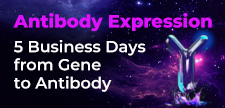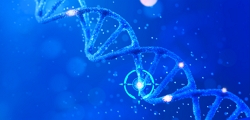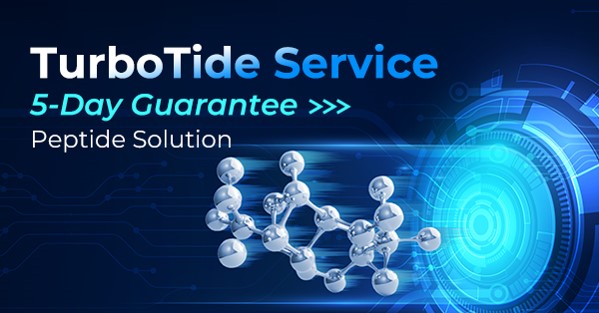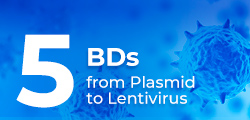-
REAGENT SERVICES
Hot!
-
Most Popular Services
-
Molecular Biology
-
Recombinant Antibody/Protein
-
Reagent Antibody
-
CRISPR Gene Editing
-
DNA Mutant Library
-
IVT RNA and LNP Formulations
-
Oligo Synthesis
-
Peptides
-
Cell Engineering
-
- Gene Synthesis FLASH Gene
- GenBrick™ Up to 200kb
- Gene Fragments Up to 3kb now
- Plasmid DNA Preparation Upgraded
- Cloning and Subcloning
- ORF cDNA Clones
- mRNA Plasmid Solutions New!
- Cell free mRNA Template New!
- AAV Plasmid Solutions New!
- Mutagenesis
- GenCircle™ Double-Stranded DNA New!
- GenSmart™ Online Tools
-
-
PRODUCTS
-
Most Popular Reagents
-
 Instruments
Instruments
-
Antibodies
-
ELISA Kits
-
Protein Electrophoresis and Blotting
-
Protein and Antibody Purification
-
Recombinant Proteins
-
Molecular Biology
-
Stable Cell Lines
-
Cell Isolation and Activation
-
 IVD Raw Materials
IVD Raw Materials
-
 Therapy Applications
Therapy Applications
-
Resources
-
- All Instruments
- Automated Protein and Antibody Purification SystemNew!
- Automated Plasmid MaxiprepHot!
- Automated Plasmid/Protein/Antibody Mini-scale Purification
- eBlot™ Protein Transfer System
- eStain™ Protein Staining System
- eZwest™ Lite Automated Western Blotting Device
- CytoSinct™ 1000 Cell Isolation Instrument
-
- Pharmacokinetics and Immunogenicity ELISA Kits
- Viral Titration QC ELISA Kits
- -- Lentivirus Titer p24 ELISA KitHot!
- -- MuLV Titer p30 ELISA KitNew!
- -- AAV2 and AAVX Titer Capsid ELISA Kits
- Residual Detection ELISA Kits
- -- T7 RNA Polymerase ELISA KitNew!
- -- BSA ELISA Kit, 2G
- -- Cas9 ELISA KitHot!
- -- Protein A ELISA KitHot!
- -- His tagged protein detection & purification
- dsRNA ELISA Kit
- Endonuclease ELISA Kit
- COVID-19 Detection cPass™ Technology Kits
-
- Automated Maxi-Plasmid PurificationHot!
- Automated Mini-Plasmid PurificationNew!
- PCR Reagents
- S.marcescens Nuclease Benz-Neburase™
- DNA Assembly GenBuilder™
- Cas9 / Cas12a / Cas13a Nucleases
- Base and Prime Editing Nucleases
- GMP Cas9 Nucleases
- CRISPR sgRNA Synthesis
- HDR Knock-in Template
- CRISPR Gene Editing Kits and Antibodies
-
![AmMag™ Quatro Automated Plasmid Purification]() AmMag™ Quatro automated plasmid purification
AmMag™ Quatro automated plasmid purification
-
![Anti-Camelid VHH]() MonoRab™ Anti-VHH Antibodies
MonoRab™ Anti-VHH Antibodies
-
![ELISA Kits]() ELISA Kits
ELISA Kits
-
![Precast Gels]() SurePAGE™ Precast Gels
SurePAGE™ Precast Gels
-
![Quatro ProAb Automated Protein and Antibody Purification System]() AmMag™ Quatro ProAb Automated Protein and Antibody Purification System
AmMag™ Quatro ProAb Automated Protein and Antibody Purification System
-
![Target Proteins]() Target Proteins
Target Proteins
-
![AmMag™ Quatro Automated Plasmid Purification]() AmMag™ Quatro automated plasmid purification
AmMag™ Quatro automated plasmid purification
-
![Stable Cell Lines]() Stable Cell Lines
Stable Cell Lines
-
![Cell Isolation and Activation]() Cell Isolation and Activation
Cell Isolation and Activation
-
 IVD Raw Materials
IVD Raw Materials
-
![Quick
Order]() Quick Order
Quick Order
-
![Quick
Order]() Quick Order
Quick Order
- APPLICATIONS
- RESOURCES
- ABOUT US
- SIGN IN My Account SIGN OUT
- REGISTER

![Antibody Formats Antibody Formats]()
Antibody Formats
Resources » Technical Resource Centers » Antibody Drug Discovery Technical Resource » Antibody Formats
- The History of Antibodies
- Antibody Basics
- Antibody Formats
- Antibody Drug Discovery Overview
- Target Identification and Validation
- Antibody Drug Discovery Webinars
- Protein Webinars
- Hit Generation and Screening
- Lead Selection and Optimization
- Candidate Selection
- Antibody Expression in E.coli
- Transient vs. Stable Expression
- Antibody Expression in Eukaryotic Hosts
Trends in clinical development of monoclonal antibodies indicates that there is a nascent shift toward the study of antibody fragments and it is likely that antibody fragments are going to be the next important class of protein-based therapeutics after monoclonal antibodies. Antibody fragments [fragments], in particular the scFvs, Fabs and VHH/VH retain full antigen-binding capacity and superior properties for research, diagnostic and therapeutic applications. Fragments are particularly useful in applications where epitope binding is sufficient for the desired effect including therapeutic applications such as virus neutralization or receptor blocking.
The smallest antigen binding fragment that retains its complete antigen binding site is the Fv fragment, which consists entirely of variable (V) regions. A soluble and flexible amino acid peptide linker is used to connect the V regions to a scFv (single chain fragment variable) fragment for stabilization of the molecule, or the constant (C) domains are added to the V regions to generate a Fab fragment [fragment, antigen-binding]. scFv and Fab are widely used fragments that can be easily produced in prokaryotic hosts. Other Ab formats include disulfide-bond stabilized scFv (ds-scFv), single chain Fab (scFab), as well as di- and multimeric antibody formats like dia-, tria- and tetra-bodies, or minibodies (miniAbs) that comprise different formats consisting of scFvs linked to oligomerization domains. The smallest fragments are VHH/VH of camelid heavy chain Abs and single domain Abs (sdAb). For most therapeutic applications, however, the Fc portion of an Ig is essential as it is instrumental in mediating cytotoxic effector functions such as ADCC and CDC.
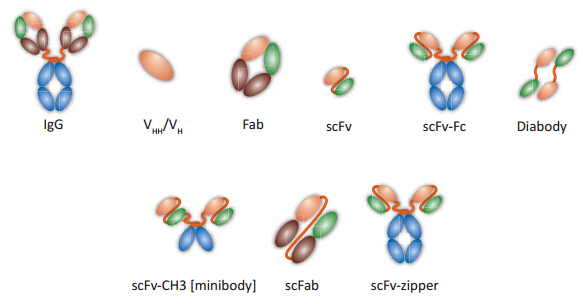
Figure 1: The modular domain architecture of Igs has been exploited to create a growing range of alternative antibody formats that spans a molecular-weight range of at least 12–150 kDa and a valency (n) range from monomeric (n = 1), dimeric (n = 2) and trimeric (n = 3) to tetrameric (n = 4) and potentially higher1. The building block that is most frequently used to create novel antibody formats is the single-chain variable (V)-domain antibody fragment (scFv), which comprises V domains from the heavy and light chain (VH and VL domain) joined by a peptide linker of ~15 amino acid residues.
Fab Antibody, scFv, VHH/VH Advantages

Excellent tissue penetration due to small size2,3

Better pharmacokinetic properties compared to parent mAbs

Binding to cryptic epitopes not accessible to full-sized mAbs4

Absence of cytotoxic effector function5

Reduced systemic load

Easy to express and produce in prokaryotic expression system6,7

Genetically stable

Less expensive, lowered production costs

Easy to engineer and modify
The previous section in this series is “Antibody Basics”. To review, click here.
GenScript Antibody Drug Discovery Services
Antibody Discovery
GenScript’s Antibody Engineering group can build antibody library with up to 1010 individual clones, to speed up your antibody discovery efforts.
Antibody Sequencing
GenScript’s advanced Antibody Sequencing technology offers fast and professional sequencing services for your monoclonal antibodies.
Assays
GenScript has developed several cell-based ADCC/CDC functional assays to profile the efficacy and potency of your therapeutic antibodies using proprietary recombinant effector cells.
Antibody Engineering
GenScript scientists’ extensive experience in antibody engineering can provide superior services such as antibody humanization, affinity maturation and more.
Antibody Production
With solid expertise in recombinant antibody (rAb) production techniques, GenScript provides a comprehensive rAb service portfolio that deliver microgram to gram quantities of pure rAb for each stage of your Ab drug discovery program.
PK/PD Study
GenScript offers over 120 tumor and inflammation models for evaluation of in vivo efficacy, PK/PD, biomarker and bioanalysis studies. GenScript Anti-idiotype Antibody services are also a powerful tool for antibody drug PK/PD and immunogenicity studies.
You can also view our Recombinant Antibody Service Selection Guide to identify services that are the best match for your application.
References
- Carter, P. J. Potent antibody therapeutics by design. Nat Rev Immunol 6, 343-357, doi:10.1038/nri1837 (2006).
- Yokota, T., Milenic, D. E., Whitlow, M. & Schlom, J. Rapid tumor penetration of a single-chain Fv and comparison with other immunoglobulin forms. Cancer Res 52, 3402-3408 (1992).
- Jain, R. K. Physiological barriers to delivery of monoclonal antibodies and other macromolecules in tumors. Cancer Res 50, 814s-819s (1990).
- Ward, E. S., Gussow, D., Griffiths, A. D., Jones, P. T. & Winter, G. Binding activities of a repertoire of single immunoglobulin variable domains secreted from Escherichia coli. Nature 341, 544-546, doi:10.1038/341544a0 (1989).
- Sanz, L., Cuesta, A. M., Compte, M. & Alvarez-Vallina, L. Antibody engineering: facing new challenges in cancer therapy. Acta Pharmacol Sin 26, 641-648, doi:10.1111/j.1745-7254.2005.00135.x (2005).
- Holliger, P. & Hudson, P. J. Engineered antibody fragments and the rise of single domains. Nat Biotechnol 23, 1126-1136, doi:10.1038/nbt1142 (2005).
- Hudson, P. J. & Souriau, C. Engineered antibodies. Nat Med 9, 129-134, doi:10.1038/nm0103-129 (2003).
Quotations and Ordering
Click the quote button, provide service informatior ana suomOur Technical Account Manager will contact you within 24 hours to finalize quoteYou review and approve final order details and priceYou provide credit card/PO information and order is placedProject is initiated immediatelyOur Project Manager will be in contacuu provide updatesOur customer service repsentatives are available 24 hours a day, Monday through Friday, to assist you.

-

